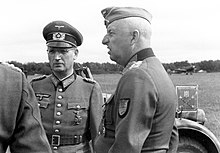Hans Speidel
Hans Speidel | |
|---|---|
 Speidel in 1944 | |
| Born | 28 October 1897 Metzingen, Kingdom of Württemberg, German Empire |
| Died | 28 November 1984 (aged 87) Bad Honnef, North Rhine-Westphalia, West Germany |
| Allegiance | Second World War |
| Awards | Knight's Cross of the Iron Cross Order of Merit of the Federal Republic of Germany |
| Other work | President of the German Institute for International and Security Affairs |
Hans Speidel (28 October 1897 – 28 November 1984) was a Nazi German general, who was one of the major military leaders of
Speidel joined the
During the early
He was the father of Brigadier General Hans Helmut Speidel and the father-in-law of European Commissioner and liberal politician Guido Brunner. A German Army military base, the General Dr Speidel Barracks in Bruchsal, was named in his honour in 1997.
Early career
Speidel was born in
Second World War

Speidel took part in the invasion of France of 1940 and in August became Chief of Staff of the military commander in France. During his time in France, Speidel was linked to the mass executions and deportations of Jewish and Communist hostages in reprisal for partisan activities by the French Resistance. Although the reprisals were never ordered by Speidel himself, but military governors Otto von Stülpnagel, and, after Otto resigned due to his reluctance to carry out the reprisals, his cousin, Carl-Heinrich von Stülpnagel, his involvement later drew controversy. Speidel would send reports on the reprisals to the Oberkommando der Wehrmacht in Berlin, and at one point attempted to justify the measures, claiming that they were aimed at the Jewish communists who were behind attacks on the Wehrmacht.[1][2]
In 1942 Speidel was sent to the Eastern Front where he served as Chief of Staff of the 5th Army Corps, and as Chief of Staff of 8th Army in 1943, where he was promoted to general.
In April 1944, Speidel was appointed Chief of Staff to Field Marshal
On 26 August 1944, Speidel answered the phone when
20 July Plot

Speidel, a professional soldier and
Following the assassination attempt, the
Cold War
In 1950, Speidel was one of the authors of the

According to an article in
After the war Speidel served for some time as professor of modern history at Tübingen and in 1950 published his book Invasion 1944: Rommel and the Normandy Campaign before being involved in both the development and creation of the new German Army (Bundeswehr) which he joined, reaching the NATO rank of full general. He was subsequently appointed Supreme Commander of the Allied NATO ground forces in Central Europe in April 1957, a command that he held until retirement in September 1963. His headquarters were at the Palace of Fontainebleau in Paris.
Visit by General Hans Speidel to Karlsruhe on the occasion of a US Army reception to mark the 10th anniversary of the Karlsruhe Department of Historical Research at US Headquarters in Europe.
In 1960, Speidel took legal action against an East German
Hans Speidel died in 1984 at Bad Honnef, North Rhine-Westphalia, aged 87.

Honours
- Honorary citizen of Metzingen, 1972
- Grand Cross with Star and Sash of the Order of Merit of the Federal Republic of Germany, 1963
- German Cross in Gold on 8 October 1942 as Oberst im Generstab in the general staff V. Armeekorps[11]
- Knight's Cross of the Iron Cross on 1 April 1944 as Generalleutnant and chief of the general staff of the 8. Armee[12]
- Goldene Württembergische Militärverdienstmedaille, 1917
- Iron Cross, first and second class, 1914 (see photo)
See also
- Assassination attempts on Adolf Hitler
References
Citations
- S2CID 159511312.
- ^ "Former Nazi Victims Protest Appointment of Nazias Nato Commander". Jewish Telegraphic Agency. 2015-03-20. Retrieved 2023-09-18.
- ^ Lapierre, Dominique, A Thousand Suns, Warner Books, 1997, p.129
- ISBN 9781612002972.
- ISBN 3-471-78572-8.
- ^ Remy 2002, p. 334.
- ISBN 9780807862742.
- ISBN 9783360019547.
- ^ Wiegrefe, Klaus, "Files Uncovered: Nazi veterans Created Illegal Army", Spiegel Online, 14 May 2014
- ^ See Plato Films Ltd v Speidel [1961] AC 1090.
- ^ Patzwall & Scherzer 2001, p. 450.
- ^ Fellgiebel 2000, p. 404.
Bibliography
- Fellgiebel, Walther-Peer (2000) [1986]. Die Träger des Ritterkreuzes des Eisernen Kreuzes 1939–1945 — Die Inhaber der höchsten Auszeichnung des Zweiten Weltkrieges aller Wehrmachtteile [The Bearers of the Knight's Cross of the Iron Cross 1939–1945 — The Owners of the Highest Award of the Second World War of all Wehrmacht Branches] (in German). Friedberg, Germany: Podzun-Pallas. ISBN 978-3-7909-0284-6.
- Patzwall, Klaus D.; Scherzer, Veit (2001). Das Deutsche Kreuz 1941 – 1945 Geschichte und Inhaber Band II [The German Cross 1941 – 1945 History and Recipients Volume 2] (in German). Norderstedt, Germany: Verlag Klaus D. Patzwall. ISBN 978-3-931533-45-8.
- Searle, Alaric (2003). Wehrmacht Generals, West German Society, and the Debate on Rearmament, 1949–1959. Westport, CT: ISBN 978-0-275-97968-3.
- Speidel, Hans (1950). Invasion 1944: Rommel and the Normandy Campaign. Chicago: Henry Regnery.
